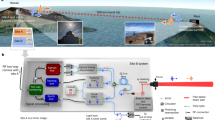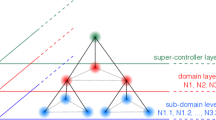Abstract
This article shows that the best capability and reliability of communication at astronomical distances can be achieved at millimetre wavelengths. The cost of communication, and the number of directions in which signals are sent and searched for are assumed to be fixed. A characteristic frequency might be 203.385 GHz, corresponding to the splitting of the ground state of the lightest atom—positronium—and coinciding with the centroid of the relic background spectrum.
This is a preview of subscription content, access via your institution
Access options
Subscribe to this journal
Receive 51 print issues and online access
$199.00 per year
only $3.90 per issue
Buy this article
- Purchase on Springer Link
- Instant access to full article PDF
Prices may be subject to local taxes which are calculated during checkout
Similar content being viewed by others
References
Cocconi, G. & Morrison, P. Nature 184, 844–846 (1959).
Oliver, B. M. The search for Extraterrestrial Intelligence (eds Morrison, P., Billingham, J. & Wolf, J.) 64–74 (NASA-SP-419, 1977).
Kardashev, N. S. in Extraterrestrial Civilizations. Problems of Interstellar Communication., (ed. Kaplan, S. A.) NASA TTF-63, 44–48 (1971).
Drake, F. D. & Helou, G., National Astronomy and Ionospheric Center. NAIC 76 (1977).
Lebedev, D. S. & Levitin, L. B. Information Propagation 9, 1–22 (1966).
Longair, M. C. & Synaev, R. A. Usp. Fiz. Nauk (USSR) 105, 41–96 (1971).
Low, F. J. Astrophys. J. Lett. 214, L115–L118 (1977).
Backer, D. C. Astr. Astrophys. 43, 395–404 (1975).
Rickett, B. J. A. Rev. Astr. Astrophys. 15, 479–504 (1977).
Oliver, J. B. & Billingham, J. Project Cyclops, NASA/Ames. Res. Centre, 51–58 (1973).
Braginsky, V. B. & Vyatchenyn, S. P. Zh. éksp. teor. Fiz. (USSR) 74, 828–832 (1978).
Woody, D. P. et al. Phys. Rev. Lett. 34, 1036–1039 (1975).
Egan, P. O. et al. Phys. Rev. A 15, 251–260 (1977).
Phillips, T. G. et al. Astrophys. J. Lett. 222, L 59–62 (1978).
Author information
Authors and Affiliations
Rights and permissions
About this article
Cite this article
Kardashev, N. Optimal wavelength region for communication with extraterrestrial intelligence: λ = 1.5 mm. Nature 278, 28–30 (1979). https://doi.org/10.1038/278028a0
Received:
Accepted:
Published:
Issue Date:
DOI: https://doi.org/10.1038/278028a0
This article is cited by
-
Novel and Emerging Applications of the Gyrotrons Worldwide: Current Status and Prospects
Journal of Infrared, Millimeter, and Terahertz Waves (2021)
-
The search for extraterrestrial intelligence
Nature (2001)
Comments
By submitting a comment you agree to abide by our Terms and Community Guidelines. If you find something abusive or that does not comply with our terms or guidelines please flag it as inappropriate.



